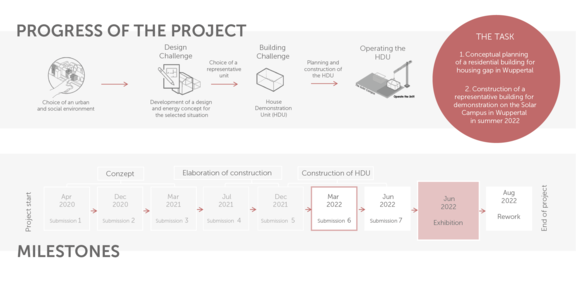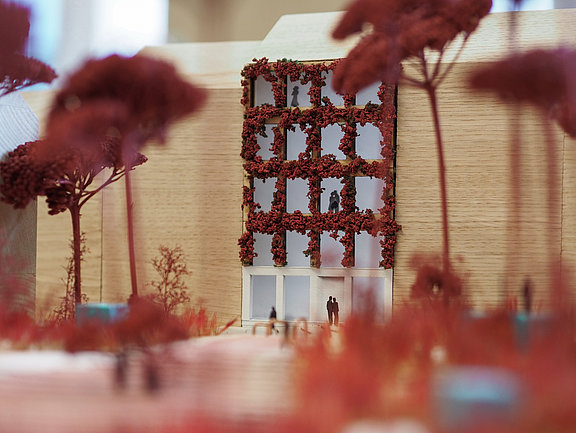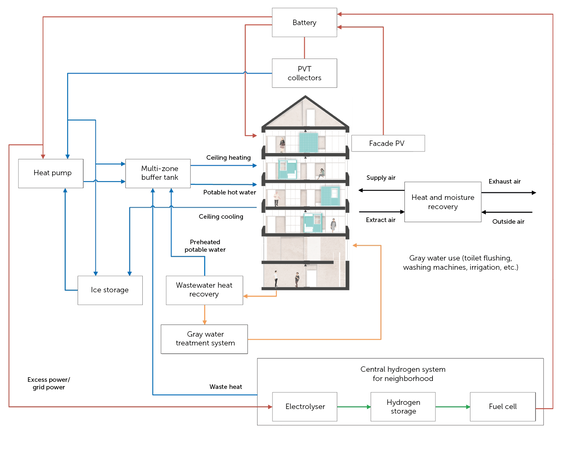![[Translate to Englisch:] Team LOCAL+ der FH Aachen überzeugt beim Solar Decathlon 2021/22](/fileadmin/_processed_/5/d/csm_LOCALplus_Titel_a4e2d7189e.jpg)
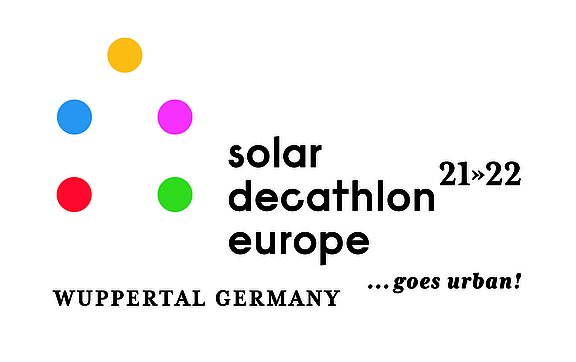
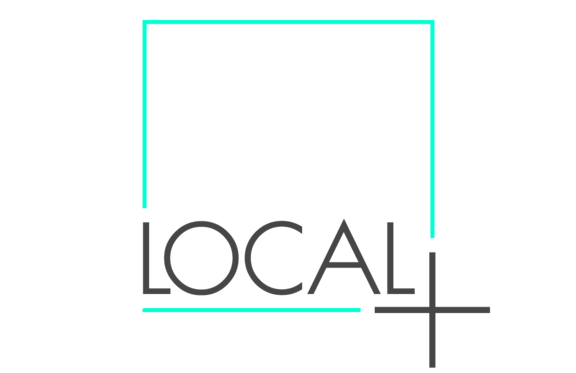
The competition, which originated in the United States, took place in Germany (Wuppertal) for the first time this year. This year, the event with the title Under the name Solar Decathlon Europe 2021/22 ...goes urban! not only focused on the building itself, but also on the future life in our cities. We supported the LOCAL+ team of the FH Aachen with our software solutions and stood by the team to give advice during the course of the project. We are very pleased that the work of LOCAL+ succeeded in several categories and in the end, the team took the 5th place in the overall ranking.
How exactly does the competition work?
Over a period of approximately 2 years, 18 teams from 11 countries designed, planned and then in June constructed their building concept in Wuppertal. The teams competed against each other in the following 10 disciplines:
- Architecture
- Building services & building physics
- Energy efficiency
- Practicability & socio-economic context
- Communication & education
- Sustainability
- Comfort
- Function
- Urban mobility
- Innovation
Both the overall building concept for the Design Challenge as well as the prototypes set up in Wuppertal on the Solar Campus for the Building Challenge are evaluated. Depending on the contest, this is done either by measurements or by an international jury of experts. In total, the teams have to master 7 submissions in the course of the competition, in which they document the progress of their project and the implementation of the tasks defined in the SDE 21/22 rules. These are taken into consideration for the overall evaluation. The team with the highest final score wins.
The Team
The FH Aachen was represented by the LOCAL+ team, which consists of more than 20 creative and ambitious students of architecture who were supported by professors, scientific staff from various departments and cooperation partners such as the Forschungszentrum Jülich. Cooperating closely, they aim to put the goal of a sustainable city into a comprehensible context and encourage both businesses and society to develop and implement new sustainable solutions. LOCAL+ has developed a working structure in which all tasks are divided into work packages. These packages were assigned to several small groups so students could work intensely on the topics. The small groups were led by team leaders who structured the ongoing tasks and ensured that the small groups achieved their set goals. The teams were divided as follows:
Team Frame
dealt with the thematic framework of the competition. This included sustainability and urban context but also affordability and viability of the project. The team members developed concepts and methods that could be implemented in the design.
Team Communication
dealt with all communication measures LOCAL+ designs to increase awareness and popularity among target groups. This ranged from corporate design, press releases, social media and website content to the design of other materials and merchandise.
Team Engineering
dealt with all energy-related components of the project. In collaboration with the Solar Institut Jülich, they developed energy-efficient systems with a focus on utility, innovative materials and sustainability.
Team Architecture and Construction
was primarily responsible for visualizing the layout for the Design Challenge (DC) and the House Demonstration Unit (HDU). In addition, members took care of all structural requirements of the building. Starting with the review and adaptation of the requirements, they elaborated all specific details.
Team Support
was responsible for the coordination, control and financial aspects of LOCAL+. The team was in contact with the SDE21/22 organizers and the different departments of the FH Aachen. It also provided support for the students during the competition.
The Concept
“WE MOVE YOUR EVERYDAY LIFE, LITERALLY.” With this vision in mind, the team presents its concept: To bring movement into the lives of the LOCAL+ residents - through flexible interior design, integrative communal living spaces and new neighborhood concepts. LOCAL+ stands for “Low Carbon Lifecycle +”. The plus refers to the broader context of the project, which not only describes materials and type of construction, but also explores and shapes ways of living and housing concepts with a holistic approach. LOCAL+ sustainably strengthens coexistence in communities through individual environments for living. In the competition, the LOCAL+ team addressed the so called “Closing Gaps” situation in urban spaces and developed an innovative residential building for a construction gap in Wuppertal.
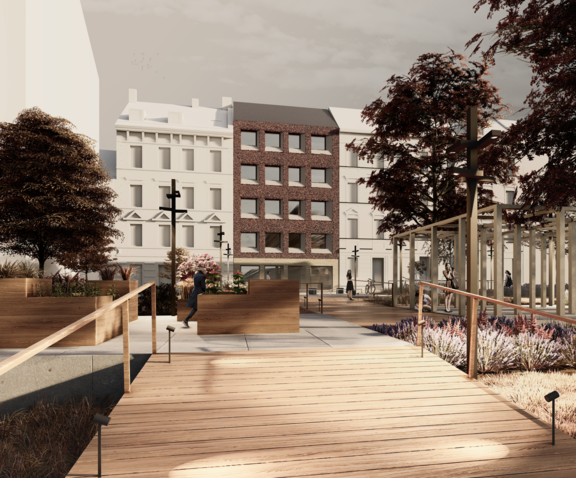
The starting point for the development of the concept was primarily the scarcity of resources and urban space, the increase in single households and the constantly changing needs for housing space. In short, the team wants to set a positive example and develop architecture that responds to ecological as well as economic and social demands. The goal is to establish the LOCAL+ concept as a model for other projects. The housing concept is intended to make optimal use of the limited space in the city, provide housing at affordable rents, and additionally create added value for the entire local community. Meanwhile, innovative and flexible floor plans ensure adaptation to personal daily routines. In addition, in order to minimize the space used individually by each person and maximize common areas, the building is divided into 2 different zones: The first floor and basement, together with the garden, form the common area, while the upper 4 floors serve private shared apartments for 3 people per floor.
Summary of concept
- Shared apartments for 12 residents
- 4 floors for living and 2 for common areas
- Net floor space living area ca. 410 m² (+ garden ca. 100 m²)
- Room-in-room concept
- Facade with green and photovoltaic elements
- Modular construction in solid wood
- Promotion of community and neighborhood
- Creating housing space for single households
- Innovative and flexible floor plan
- Construction of a sustainable building in terms of design, energy & resource use
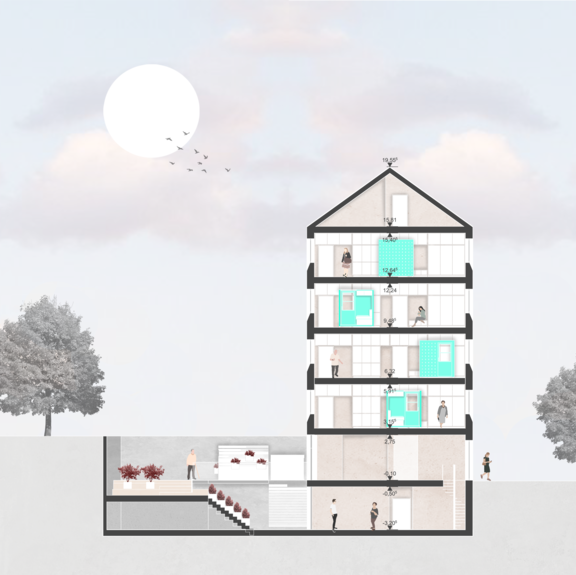
The CUBE
The highlight of the design is a fully mobile living space that offers residents everything they need on a compact room area. The so-called CUBE is designed to be moved throughout the day according to the needs of the residents. This allows for a completely flexible and adaptable floor plan in each apartment of the LOCAL+ house.
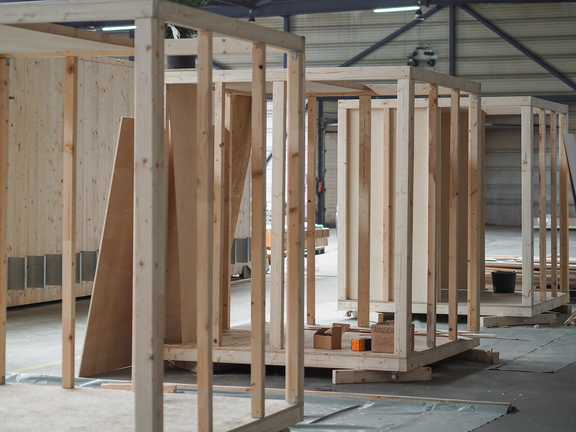
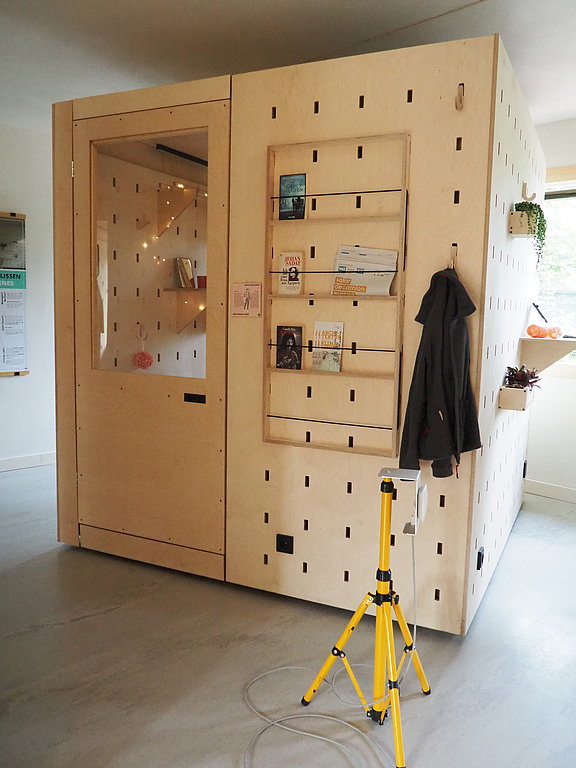
Thus, on the one hand, these freely movable room units provide spatial diversity by allowing adaptable zoning of rooms, but on the other hand, they function as a personal retreat and work space. The minimized size puts interaction, communication and living together around the CUBE in the foreground and reduces the individual living space of each person (see Fig. 5).
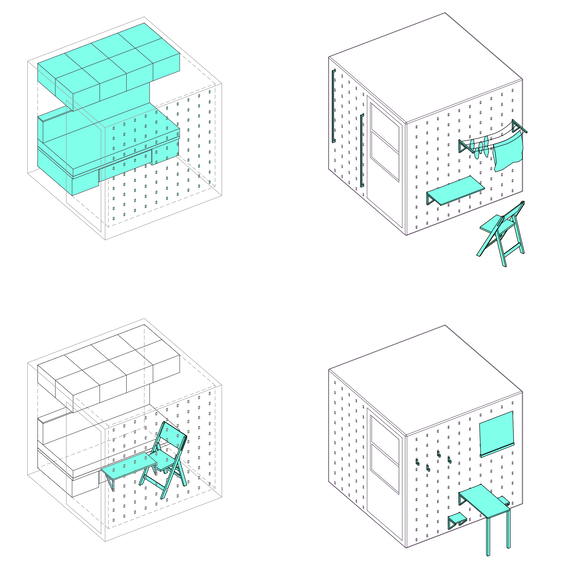
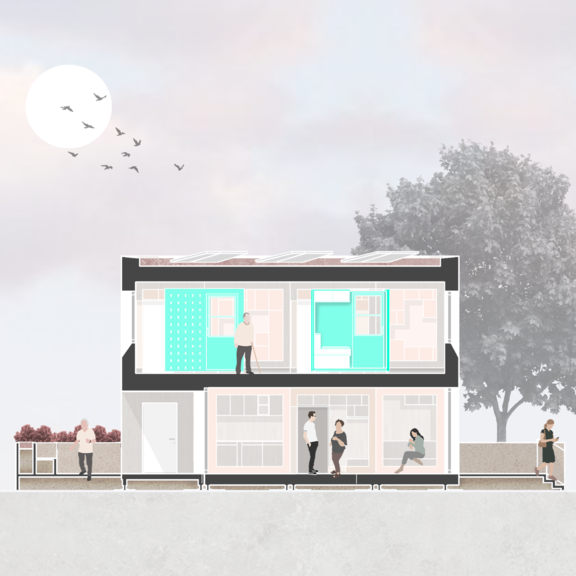
Energy efficiency through innovative building services concept
The aim of LOCAL+ was to develop a building that produces surplus energy through innovative and forward-looking systems: a so-called energy-plus house. Energy generation from renewable sources is intended to ensure that LOCAL+ is innovative, sustainable and future-oriented and comes closer to the vision of an almost self-sufficient building. In combination with other components, the central hydrogen system, which is the main component of the energy supply system, promises a degree of self-sufficiency of up to
65 %. In terms of building technology, the team not only had the building itself in mind, but they also developed an innovative and sustainable energy concept for the neighborhood, taking into account the existing building stock. Further components of the building services concept are an underground ice storage, photovoltaic thermal collectors (PVT) and a heat pump with an intelligent control mechanism. In the practical implementation, it was decided not to install the hydrogen system due to the short construction and standing time. In addition, the ice storage was reduced in size, since here, too, an underground installation would have been neither reasonable nor feasible. Apart from these situational limitations, the system could be implemented in line with the planning. The energy concept of the new building was put in practice as follows:
Power generation
For power generation, PVT modules have been installed on the roof (110 m2; 52 PVT modules with 18.5 kWp output) of the building. In addition, 56 m2 of PV panels with 9 kWp output are integrated on the southwest facade of the building. The electricity produced is delivered directly to the apartments during the day according to demand. Excess electricity from the PV system can be stored in the battery and later used to cover energy consumption during the night.
Hot and heating water
The total heating demand of the building is very low. However, the hot water demand is significantly higher than the heating demand, as the building is planned for 12 residents. The central component of the system technology is a heat pump with ice storage and a PVT system for hot and cold water supply. PVT collectors provide low-temperature heat for the regeneration of the ice storage and as a heat source for the heat pump. An ice storage tank with a capacity of 10 m3 was planned for the concept, which is placed underground at the back of the building. The ice storage partially serves as a seasonal energy storage system, which is a non-insulated ice storage coupled to the ground. Ultimately, this ice storage is a heat source for brine-water-heat pumps (10.5 kW thermal capacity at B0/W35). Combining the 3 systems significantly increases the annual performance factor of the heat pump. In addition, the PV modules are continuously cooled down, which leads to an increase in the efficiency of the PV modules.
Heating and cooling
For heating and cooling, a clay-based (water-loaded) thermally activated room ceiling has been integrated. When using this system, one goal is to reduce the supply temperature for heating and increase the supply temperature for cooling so that the system operates more efficiently. Due to the inherent property of the clay plaster that is used, control over humidity within a room is maintained. Additionally, the clay reduces sound reflection and provides comfortable room acoustics.
Ventilation
To ensure air quality in the building with a low energy input, a central ventilation system with heat and enthalpy recovery system is installed. The CUBEs each have a fan that conveys the extract air out of the CUBE. Fresh air flows in through a porous plate in the ceiling of the CUBE.
Construction and sustainability
The building has been designed as a modular structure in solid timber. In addition to the high degree of prefabrication, this also guarantees planning reliability and optimized use of resources. Through the clever combination of recycled building materials, components and detachable construction elements, LOCAL+ also supports the idea of the cradle-to-cradle philosophy as well as that of urban mining. The basic idea in both cases is the idea of recycling, which not only minimizes waste in the construction industry, but also the CO₂ footprint.
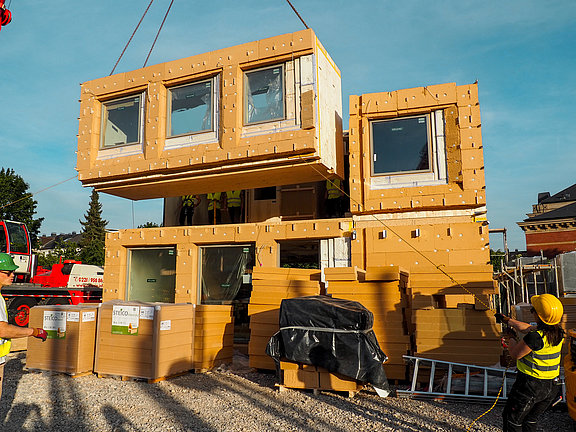
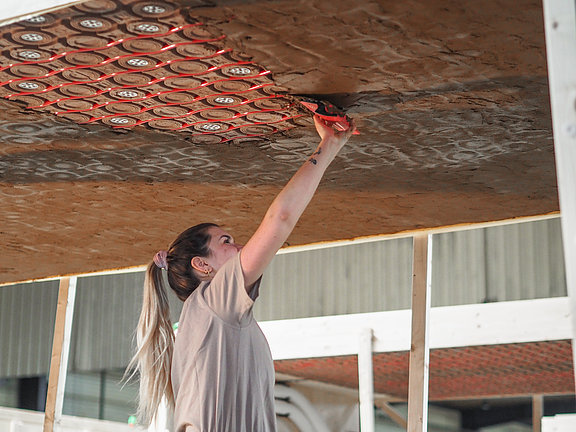
Two years' work pays off
The project started in fall 2019 with the module “Building in Existing Environments” as a semester project at the FH Aachen. At the end of the semester, it was decided to officially submit the project to the Solar Decathlon 2021/22, whereupon the project team was provided with its own office in March 2020 and began further planning. The organization of the tasks and the team itself already took place in the first days. In the following weeks, the structure of the respective topics was deepened. In addition, work processes were analyzed to identify weaknesses, which were subsequently optimized. In mid-March, the team had to move to home office because of COVID-19. From then on, all work processes and communication were carried out via video conferences or telephone calls. Until December 2021, the team worked on the details of the individual competition categories, with 5 mandatory competition submissions that dealt with the different aspects (sustainability, materiality, energy or construction). During this phase, the energy concept was also created using the LINEAR software. From January 2022, the construction phase started in preparation for the exhibition in Wuppertal. During the construction phase, the model was prefabricated in Aachen until it was then dismantled in May 2022, transported to Wuppertal and reassembled on-site by the team.
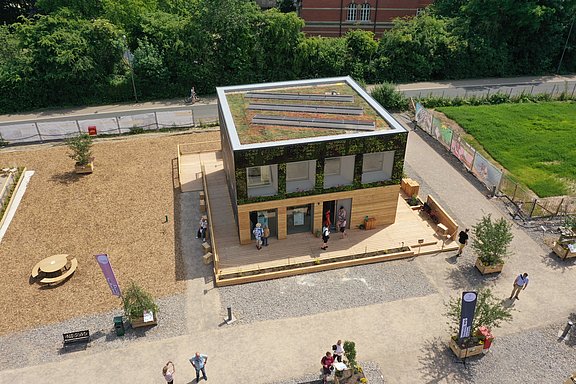
Storm destroys parts of the superstructure
Shortly after the start of construction work in Wuppertal, another major challenge awaited the team. Already during transport as well as at the beginning of the construction phase, a storm in Wuppertal caused water damage to the building structure. During countless extra hours, material had to be replaced and repairs made. However, many helping hands and an exemplary team spirit ultimately ensured that the team managed to complete the construction site on time for the opening of the exhibition and to present the finished project to the visitors. And this was something to be proud of. Both visually and functionally, the students and project participants designed and constructed a magnificent building that over 115,000 people admired during the public exhibition.
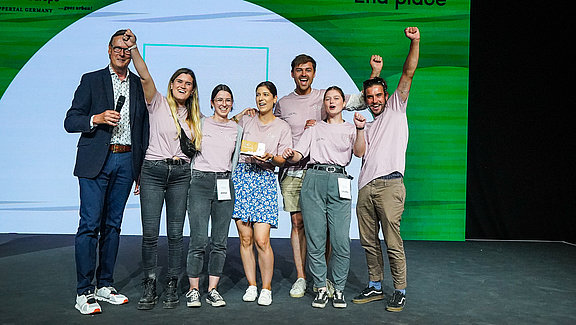
Fivefold victory for the LOCAL+ team
With the first place in the category Urban Mobility, the overall concept was just as convincing as with second place in the categories Building Technology and Building Physics and in the category Communication and Education. Visitors also rewarded the team with second place in the Peoples Choice Award. In the scope of the additional Solar Award, the team was furthermore able to achieve second place, which highlighted the innovative design of the technical systems in particular. At the end of the competition, the team from Aachen achieved a respectable 5th place in the overall standings. The overall winner of the competition this year was the RoofKIT team from the Karlsruhe Institute of Technology. All projects and results can be found in details on the Solar Decathlon website. Our warmest congratulations to all teams and especially to team LOCAL+ from our hometown Aachen for the outstanding performance.
